Preventing Patent Risks in Artificial Intelligence Industry for Sustainable Development: A Multi-Level Network Analysis
Abstract
:1. Introduction
2. Literature Review
2.1. Multi-Level Network Analysis
2.2. Development of Patent Risks
3. Research Methodology and Framework
3.1. Retrieval of Patent Information
3.2. Patent-Based Multi-Level Network Model
4. Case Study
4.1. Market Network
4.2. Technology Network
4.3. Patentee Network
4.4. Patentee–Market Network
4.5. Patentee–Technology Network
5. Discussion and Implications
Author Contributions
Funding
Acknowledgments
Conflicts of Interest
References
- Chang, Y.W. Tracking scientometric research in Taiwan using bibliometric and content analysis. J. Libr. Inf. Stud. 2012, 10, 1–20. [Google Scholar]
- Choe, H.; Lee, D.H. The structure and change of the research collaboration network in Korea (2000–2011): Network analysis of joint patents. Scientometrics 2017, 111, 917–939. [Google Scholar] [CrossRef]
- Kim, H.; Song, J.S. Social network analysis of patent infringement lawsuits. Technol. Forecast. Soc. Chang. 2013, 80, 944–955. [Google Scholar] [CrossRef]
- Park, I.; Yoon, B. A semantic analysis approach for identifying patent infringement based on a product–patent map. Technol. Anal. Strateg. Manag. 2014, 26, 855–874. [Google Scholar] [CrossRef]
- Starr, C. Social benefits versus technological risks. Science 1969, 165, 1232–1238. [Google Scholar] [CrossRef]
- Haynes, J. Risk as an Economic Factor. Q. J. Econ. 1985, 9, 409–449. [Google Scholar] [CrossRef]
- Willett, A.H. The Economic Theory of Risk and Insurance; University of Pennylvania Press: Philadelphia, PA, USA, 1951. [Google Scholar]
- Knight, H.F. Risk, Uncertainty and Profit; Houghton Mifflin Company: Boston, MA, USA, 1921. [Google Scholar]
- Berglund, H.; Hellstrom, T. Enacting risk in independent technological innovation. Int. J. Risk Assess. Manag. 2002, 3, 205–221. [Google Scholar] [CrossRef] [Green Version]
- Panagopoulos, A.J. The Effect of IP Protection on Radical and Incremental Innovation Authors. J. Knowl. Econ. 2011, 2, 393–404. [Google Scholar] [CrossRef]
- Sandner, P.G.; Block, J. The market value of R&D, patents and trademarks. Res. Policy 2011, 40, 969–985. [Google Scholar]
- Hsu, P.H.; Lee, H.H.; Liu, A.Z.; Zhang, Z. Competitiveness in Technological Innovation and Its Implications for Bondholders; Social Science Electronic Publishing: Rochester, NY, USA, 2011. [Google Scholar]
- Russell, S.; Norvig, P. Artificial Intelligence—A Modern Approach; Upper Saddle River: Bergen, NJ, USA, 2010. [Google Scholar]
- Stone, P.; Brooks, R.; Brynjolfsson, E.; Calo, R.; Etzioni, O.; Hager, G.; Hirschberg, J.; Kalyanakrishnan, S.; Kamar, E.; Kraus, S.; et al. Artificial Intelligence and Life in 2030. One Hundred Year Study on Artificial Intelligence. Available online: https://ai100.stanford.edu/sites/g/files/sbiybj9861/f/ai100report10032016fnl_singles.pdf (accessed on 2 June 2020).
- Cath, C.; Wachter, S.; Mittelstadt, B.; Taddeo, M.; Floridi, L. Artificial Intelligence and the ‘Good Society’: The US, EU, and UK approach. Sci. Eng. Ethics 2018, 24, 505–528. [Google Scholar]
- The White House. American AI Initiative One Year Annual Report. Available online: https://www.whitehouse.gov/wp-content/uploads/2020/02/American-AI-Initiative-One-Year-Annual-Report.pdf (accessed on 10 June 2020).
- Strategic Council for AI Technology. Artificial Intelligence Technology Strategy. Available online: https://www.nedo.go.jp/content/100865202.pdf (accessed on 12 June 2020).
- The State Council of the People’s Republic of China. A Next Generation Artificial Intelligence Development Plan. Available online: http://www.gov.cn/zhengce/content/2017-07/20/content_5211996.htm (accessed on 15 June 2020).
- The State Council of the People’s Republic of China. Report on the Work of the Government (2019). Available online: http://english.www.gov.cn/premier/speeches/2019/03/16/content_281476565265580.htm (accessed on 20 June 2020).
- Snijders, T.A.B.; Bosker, R. Multi-Level Analysis; SAGE: London, UK, 1999. [Google Scholar]
- Snijders, T.A.B. The Multiple Flavours of Multilevel Issues for Networks. In Multilevel Network Analysis for the Social Sciences; Lazega, E., Snijders, T., Eds.; Springer: Berlin, Germany, 2016. [Google Scholar]
- Wang, P.; Robins, G.; Pattison, P.; Lazega, E. Exponential random graph models formultilevel networks. Soc. Netw. 2013, 35, 96–115. [Google Scholar] [CrossRef] [Green Version]
- Lazega, E.; Snijders, T.A. Multilevel Network Analysis for the Social Sciences; Springer: Heidelberg, Germany, 2016. [Google Scholar]
- Goeldner, M.; Herstatt, C.; Tietze, F. The emergence of care robotics—A patent and publication analysis. Technol. Forecast. Soc. Chang. 2015, 92, 115–131. [Google Scholar] [CrossRef] [Green Version]
- Bellotti, E. Getting funded. Multi-level network of physicists in Italy. Soc. Netw. 2012, 34, 215–229. [Google Scholar] [CrossRef]
- Lazega, E.; Jourda, M.T.; Mounier, L.; Stofer, R. Catching up with big fish in the big pond? Multi-level network analysis through linked design. Soc. Netw. 2008, 30, 159–176. [Google Scholar] [CrossRef] [Green Version]
- Snijders, T.A.B.; Lomi, A.; Torlò, V. A model for the multiplex dynamics of two-mode and one-mode networks, with an application to employment preference, friendship, and advice. Soc. Netw. 2013, 35, 265–276. [Google Scholar] [CrossRef] [Green Version]
- Everett, M.G.; Chiara, B.; Borgatti, S.P.; Johan, K. Measuring knowledge and experience in two mode temporal networks. Soc. Netw. 2018, 55, 63–73. [Google Scholar] [CrossRef] [Green Version]
- Bellotti, E.; Kronegger, L.; Guadalupi, L. The evolution of research collaboration within and across disciplines in Italian Academia. Scientometrics 2016, 109, 783–811. [Google Scholar] [CrossRef] [Green Version]
- Brennecke, J.; Rank, O. The firm’s knowledge network and the transfer of advice among corporate inventors—A multilevel network study. Res. Policy 2017, 46, 768–783. [Google Scholar] [CrossRef]
- Barnett, G.A.; Park, H.W.; Jiang, K.; Tang, C.; Aguillo, I.F. A multi-level network analysis of web-citations among the world’s universities. Scientometrics 2014, 99, 5–26. [Google Scholar] [CrossRef]
- Meredith, C. Connecting the Dots. A Social Network Perspective on Social-Organizational Processes in Secondary Schools; KU Leuven: Leuven, Belgium, 2017. [Google Scholar]
- Abbasi, A.; Hossain, L.; Uddin, S.; Rasmussen, K.J.R. Evolutionary dynamics of scientific collaboration networks: Multi-levels and cross-time analysis. Scientometrics 2011, 89, 687–710. [Google Scholar] [CrossRef] [Green Version]
- Blackman, M. Provision of patent information: A national patent office perspective. World Pat. Inf. 1999, 17, 115–123. [Google Scholar] [CrossRef]
- Reitzig, M.; Henkel, J.; Heath, C. On sharks, trolls, and their patent prey—Unrealistic damage awards and firm’s strategies of ‘being infringed’. Res. Policy 2007, 36, 134–154. [Google Scholar] [CrossRef]
- Wang, S. Research on the Patent Risk Assessment in Automatic Control Technology. In Proceedings of the 2012 International Conference on Computer Science and Electronics Engineering, Hangzhou, China, 23–25 March 2012. [Google Scholar]
- Leon, I.D.; Donoso, J.F. The Impact of IP Risk in the Development of IP Markets. In Innovation, Startups and Intellectual Property; Leon, I.D., Donoso, J.F., Eds.; Springer: Berlin/Heidelberg, Germany, 2017. [Google Scholar]
- Lee, C.; Song, B.; Park, Y. How to assess patent infringement risks: A semantic patent claim analysis using dependency relationships. Technol. Anal. Strateg. Manag. 2013, 25, 23–38. [Google Scholar] [CrossRef]
- Jun, S.; Park, S. Examining technological competition between BMW and Hyundai in the Korean car market. Technol. Anal. Strateg. Manag. 2016, 28, 156–175. [Google Scholar] [CrossRef]
- Wang, S.; Wang, H. Evaluation method on R&D alliance patent risk based on cloud model. In Proceedings of the Management Science and Industrial Engineering International Conference (MSIE), Harbin, China, 8–9 January 2011. [Google Scholar]
- Shin, J.; Park, Y. Generation and application of patent claim map: Text mining and network analysis. J. Intellect. Prop. Rights 2005, 10, 198–205. [Google Scholar]
- Kasravi, K.; Risov, M. Multivariate patent similarity detection. In Proceedings of the 42nd Hawaii International Conference on System Sciences, Big Island, HI, USA, 5–8 January 2009. [Google Scholar]
- Lee, S.; Yoon, B.; Park, Y. An approach to discovering new technology opportunities: Keyword-based patent map approach. Technovation 2009, 29, 481–497. [Google Scholar] [CrossRef]
- Tseng, C.Y. Technological innovation and knowledge network in Asia: Evidence from comparison of information and communication technologies among six countries. Technol. Forecast. Soc. Chang. 2009, 76, 654–663. [Google Scholar] [CrossRef]
- Tsai, C.Y.; An, N.N. Network Analysis of Patent Infringement Lawsuits in Pharmaceutical Industry. In Proceedings of the Fourth International Conference on Informatics & Applications, Okayama, Japan, 12–16 July 2015. [Google Scholar]
- Borgatti, S.P.; Everett, M.G.; Freeman, L.C. UCINET 6 for Windows: Software for Social Network Analysis; Analytic Technologies: Cambridge, MA, USA, 2002. [Google Scholar]
- Derwent Innovation Index. Derwent Innovation. 2020. Available online: https://clarivate.com/products/derwent-innovation/ (accessed on 20 March 2020).
- Huang, L.; Miao, W.; Zhang, Y.; Yu, H.Z.; Wang, K.R. Patent Network Analysis for Identifying Technological Evolution: A Case Study of China’s Artificial Intelligence Technologies. In Proceedings of the 2017 Portland International Conference on Management of Engineering and Technology, Portland, OR, USA, 9–13 July 2017. [Google Scholar]
- Tang, L.; Shapira, P.; Youtie, J. Is there a clubbing effect underlying Chinese research citation increases? J. Assoc. Inf. Sci. Technol. 2015, 66, 1923–1932. [Google Scholar] [CrossRef] [Green Version]
- Zheng, J.; Zhao, Z.Y.; Zhang, X.; Chen, D.Z.; Huang, M.H. International collaboration development in nanotechnology: A perspective of patent network analysis. Scientometrics 2014, 98, 683–702. [Google Scholar] [CrossRef]
- Érdi, P.; Makovi, K.; Somogyvári, Z.; Strandburg, K.; Tobochnik, J.; Volf, P.; Zal´anyi, L. Prediction of emerging technologies based on analysis of the U.S. patent citation network. Scientometrics 2013, 95, 225–242. [Google Scholar] [CrossRef] [Green Version]
- Criscuolo, P. The ‘home advantage’ effect and patent families. A comparison of OECD triadic patents, the USPTO and the EPO. Scientometrics 2006, 66, 23–41. [Google Scholar] [CrossRef]
- Freeman, L.C. A set of measures of centrality based on betweenness. Sociometry 1977, 40, 35–41. [Google Scholar] [CrossRef]
- Freeman, L.C. Centrality in social networks: Conceptual clarification. Soc. Netw. 1979, 1, 215–239. [Google Scholar] [CrossRef] [Green Version]
- Bonacich, P. Factoring and weighting approaches to status scores and clique identification. J. Math. Sociol. 1972, 2, 113–120. [Google Scholar] [CrossRef]
- Li, B.; Hou, B.; Yu, W.; Lu, X.; Yang, C. Applications of artificial intelligence in intelligent manufacturing: A review. Front. Inf. Technol. Electron. Eng. 2017, 18, 86–96. [Google Scholar] [CrossRef]
- Wurtz, F.; Bigeon, J.; Poirson, C. A methodology and a tool for the computer aided design with constraints of electrical devices. IEEE Trans. Magn. 1996, 32, 1429–1432. [Google Scholar] [CrossRef]
- Patel, V.L.; Shortliffe, E.H.; Stefanelli, M.; Szolovits, P.; Berthold, M.R.; Bellazzi, R.; Abu-Hanna, A. The coming of age of artificial intelligence in medicine. Artif. Intell. Med. 2009, 46, 5–17. [Google Scholar] [CrossRef] [Green Version]
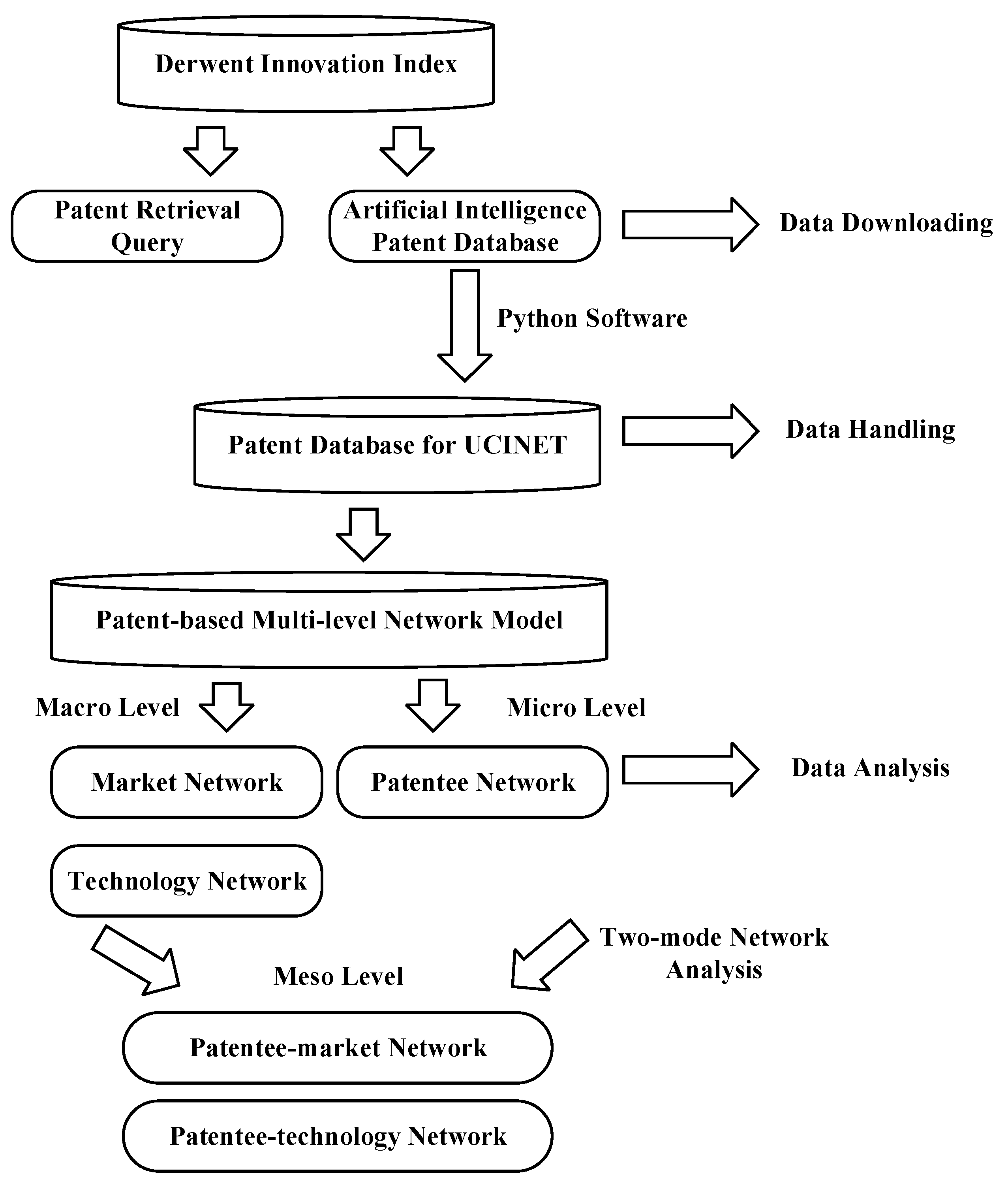
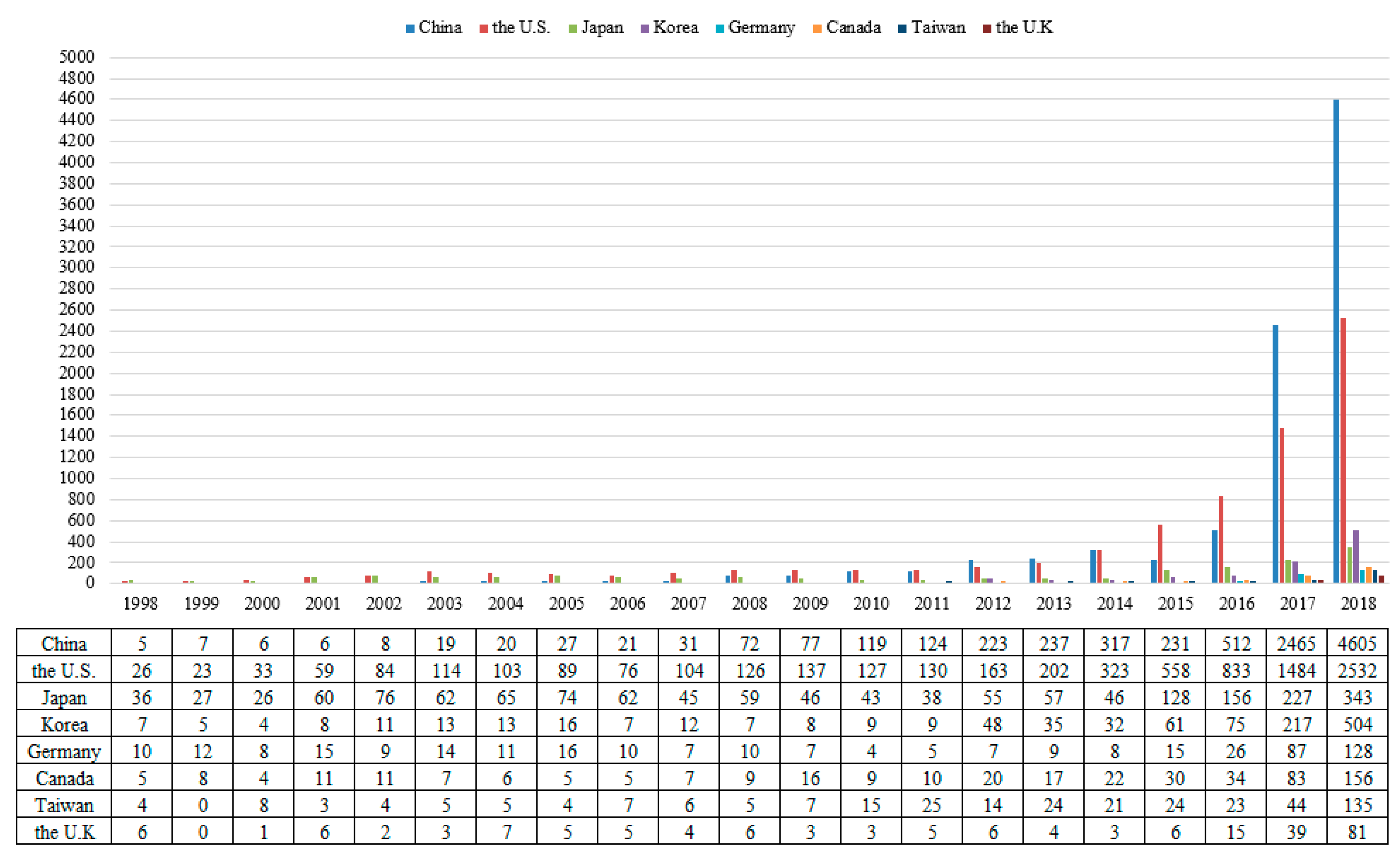
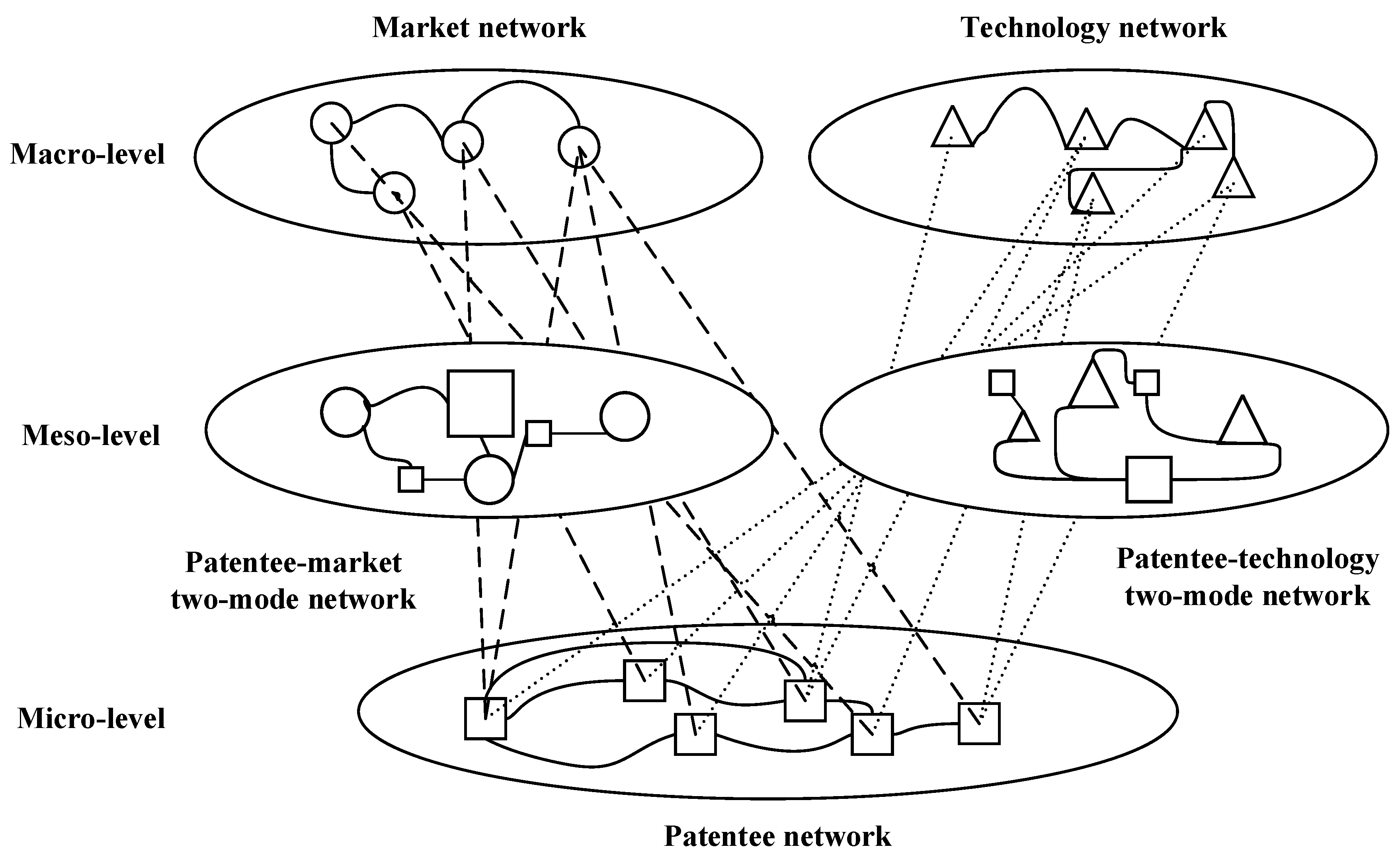
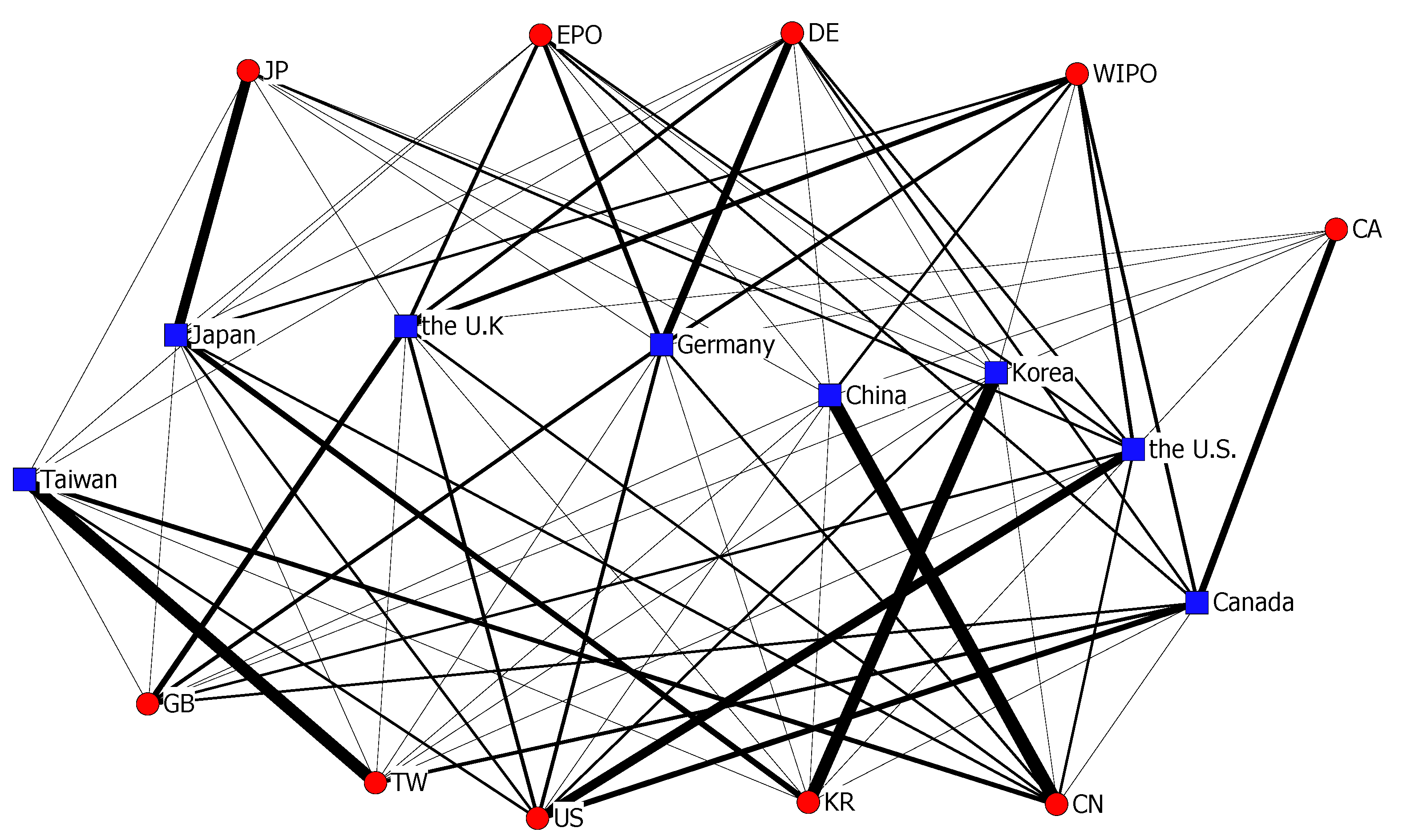

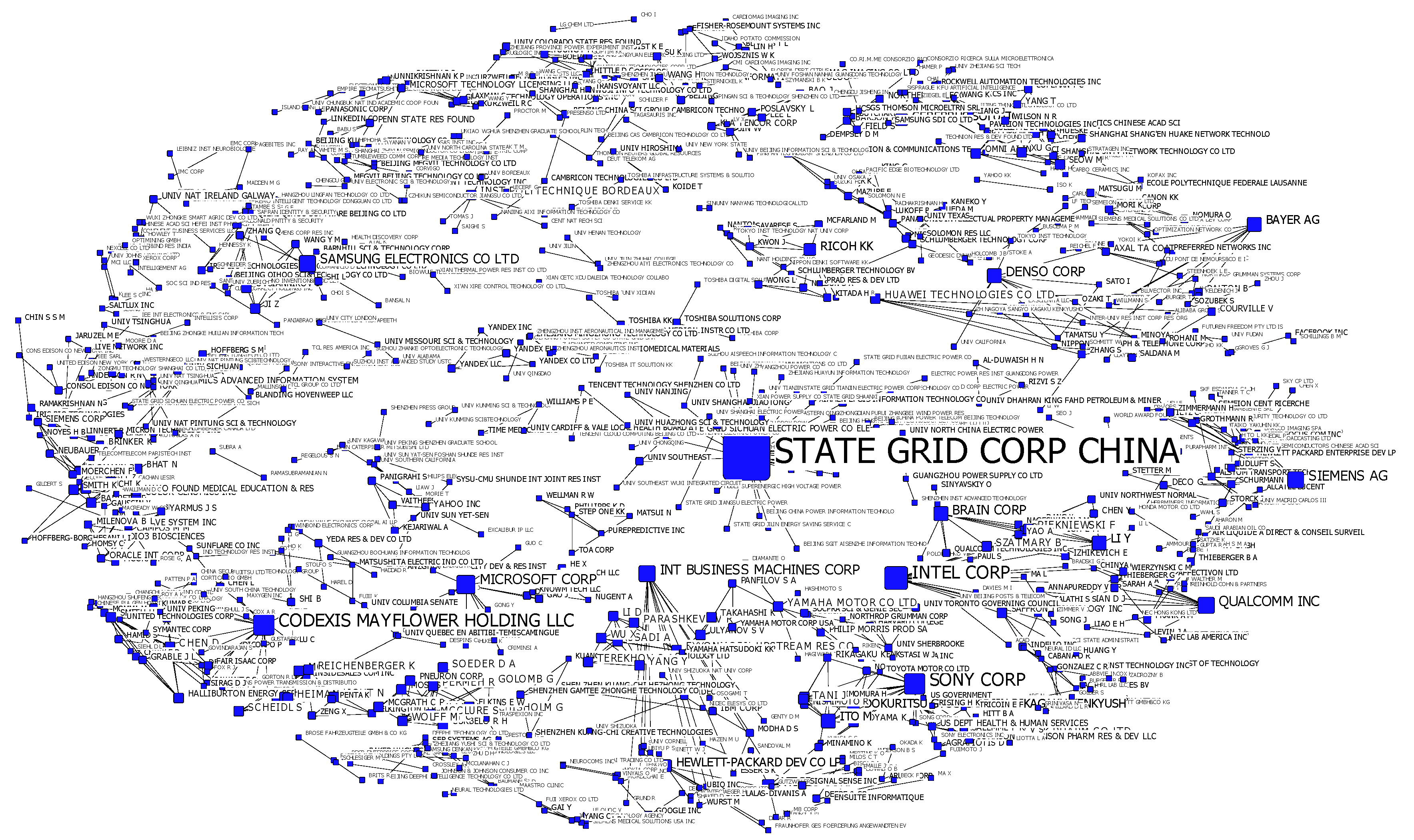
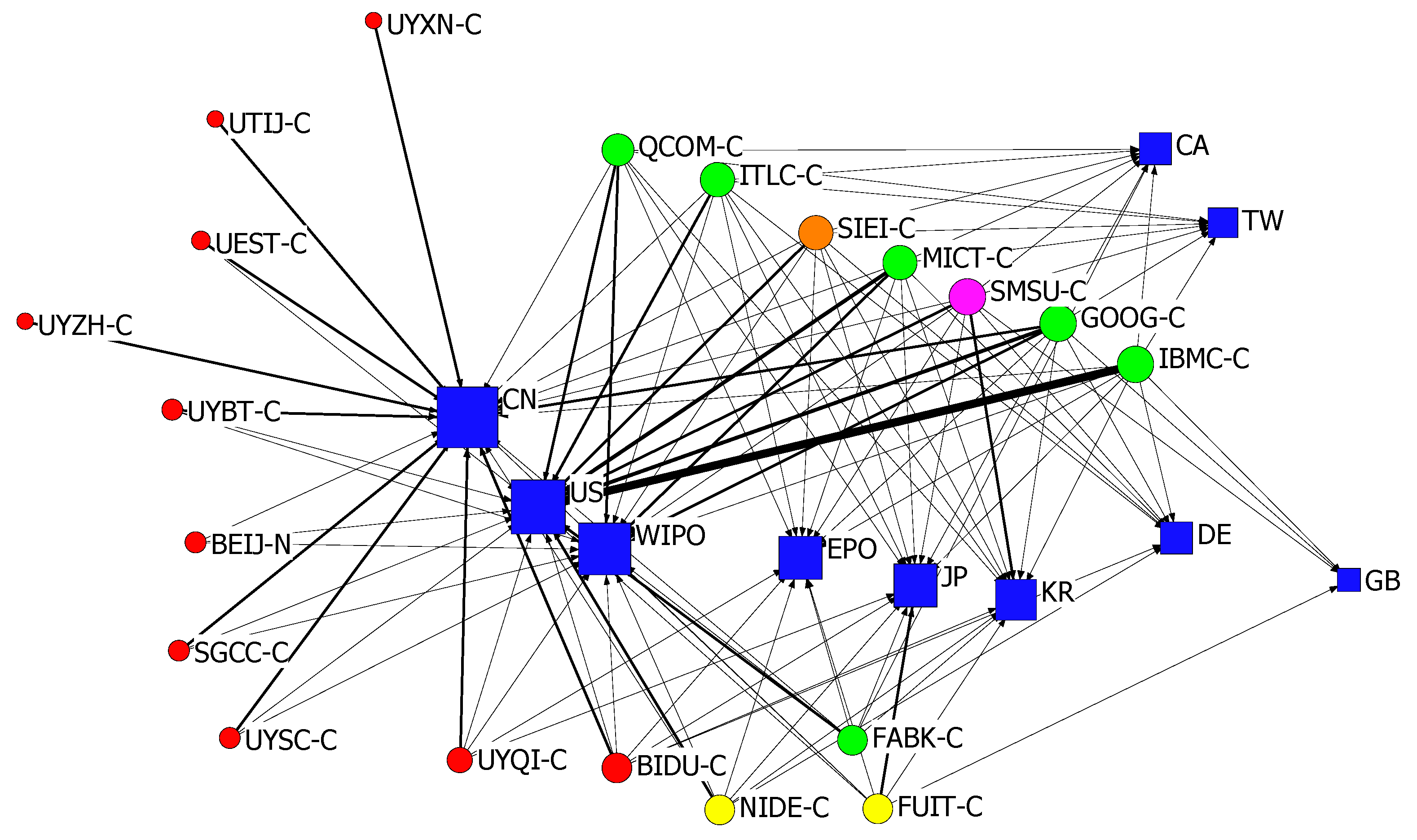

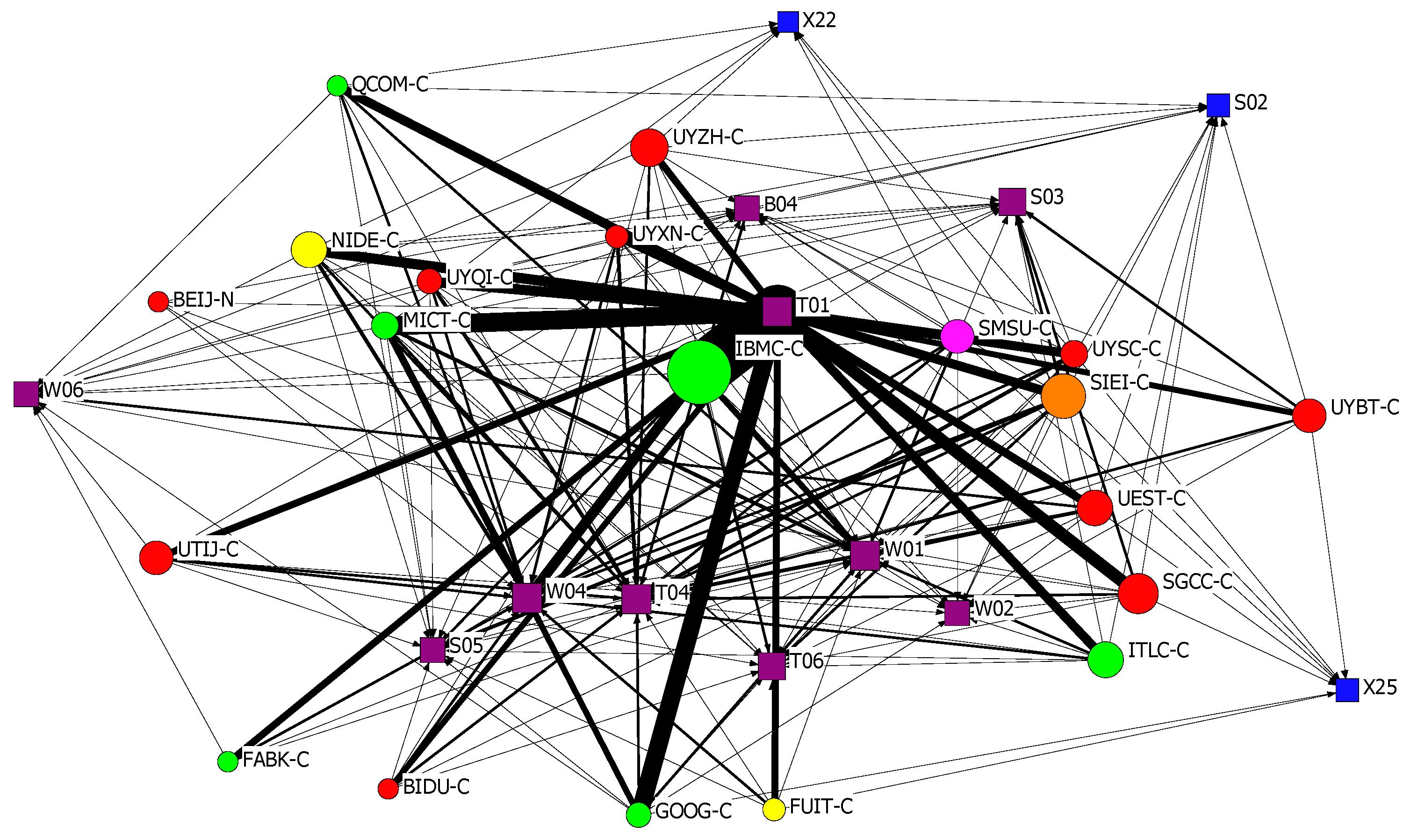
| Derwent Class Code | Technological Fields | Betweenness Centrality | Degree Centrality | Eigenvector Centrality |
|---|---|---|---|---|
| T01 | Digital Computers | 8557.116 | 170 | 0.293 |
| T06 | Process and Machine Control | 1529.039 | 103 | 0.243 |
| X25 | Industrial Electric Equipment | 606.145 | 71 | 0.187 |
| S03 | Scientific Instrumentation | 597.972 | 76 | 0.213 |
| T04 | Computer Peripheral Equipment | 373.217 | 68 | 0.207 |
| W04 | Audio/Video Recording and Systems | 255.737 | 63 | 0.204 |
| S02 | Engineering Instrumentation | 220.156 | 56 | 0.184 |
| W01 | Telephone and Data Transmission Systems | 160.088 | 55 | 0.193 |
| X22 | Automotive Electrics | 155.736 | 45 | 0.154 |
| S05 | Electrical Medical Equipment | 130.458 | 48 | 0.171 |
| Assignee | Degree Centrality | Country Origin |
|---|---|---|
| SGCC-C | 35 | China |
| ITLC-C | 15 | the U.S. |
| SONY-C | 14 | Japan |
| CODE-Non-standard | 14 | the U.S. |
| MICT-C | 12 | the U.S. |
| SIEI-C | 11 | Germany |
| IBMC-C | 11 | the U.S. |
| QCOM-C | 11 | the U.S. |
| SMSU-C | 10 | Korea |
| BRAI-Non-standard | 9 | the U.S. |
| Assignee | Number of Patents | Country Origin |
|---|---|---|
| IBMC-C | 941 | the U.S. |
| MICT-C | 308 | the U.S. |
| GOOG-C | 290 | the U.S. |
| SGCC-C | 198 | China |
| SMSU-C | 160 | Korea |
| NIDE-C | 156 | Japan |
| UYQI-C | 147 | China |
| QCOM-C | 136 | the U.S. |
| ITLC-C | 131 | the U.S. |
| SIEI-C | 129 | Germany |
| UYSC-C | 125 | China |
| UEST-C | 120 | China |
| FUIT-C | 103 | Japan |
| UYZH-C | 103 | China |
| FABK-C | 101 | the U.S. |
| UTIJ-C | 95 | China |
| UYXN-C | 93 | China |
| BIDU-C | 90 | China |
| UYBT-C | 82 | China |
| BEIJ-N | 76 | China |
| Derwent Class Code | Technological Fields | Betweenness Centrality | Degree Centrality | Eigenvector Centrality |
|---|---|---|---|---|
| T01 | Digital Computers | 271.019 | 20 | 0.243 |
| T04 | Computer Peripheral Equipment | 271.019 | 20 | 0.243 |
| W01 | Telephone and Data Transmission Systems | 237.488 | 19 | 0.231 |
| W04 | Audio/Video Recording and Systems | 233.145 | 19 | 0.232 |
| S03 | Scientific Instrumentation | 172.673 | 14 | 0.195 |
| T06 | Process and Machine Control | 171.000 | 15 | 0.201 |
| S05 | Electrical Medical Equipment | 144.910 | 15 | 0.192 |
| W02 | Broadcasting, Radio and Line Transmission Systems | 130.688 | 13 | 0.180 |
| B04 | Natural products and polymers | 110.358 | 12 | 0.164 |
| W06 | Aviation, Marine and Radar Systems | 107.909 | 13 | 0.170 |
Publisher’s Note: MDPI stays neutral with regard to jurisdictional claims in published maps and institutional affiliations. |
© 2020 by the authors. Licensee MDPI, Basel, Switzerland. This article is an open access article distributed under the terms and conditions of the Creative Commons Attribution (CC BY) license (http://creativecommons.org/licenses/by/4.0/).
Share and Cite
Yang, X.; Yu, X. Preventing Patent Risks in Artificial Intelligence Industry for Sustainable Development: A Multi-Level Network Analysis. Sustainability 2020, 12, 8667. https://doi.org/10.3390/su12208667
Yang X, Yu X. Preventing Patent Risks in Artificial Intelligence Industry for Sustainable Development: A Multi-Level Network Analysis. Sustainability. 2020; 12(20):8667. https://doi.org/10.3390/su12208667
Chicago/Turabian StyleYang, Xi, and Xiang Yu. 2020. "Preventing Patent Risks in Artificial Intelligence Industry for Sustainable Development: A Multi-Level Network Analysis" Sustainability 12, no. 20: 8667. https://doi.org/10.3390/su12208667





